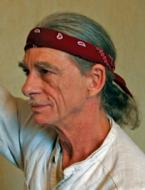Robert Amaker

Bob (Robert) Amaker has a BA in mathematics but he is also a writer, a musician, and a martial arts master. A man of knowledge and a man of rhythm, he is first and foremost a man of art. Today, at the age of 65 he is still genuinely interested in the two passions of his early youth: drums and Taijiquan. With years of practice he became a master in both. Drums and Taijiquan are not just a hobby and not even a calling: they are Bob’s manner of being. They are, furthermore, his manner of being irresistibly energetic, cheerful, frank, and free in his judgments and actions. This allows him to develop his spirit, which, he admits, is the most important thing in life.
A short note would not be enough to sketch Robert Amaker’s biography even in its general outlines: as the facts of this biography clearly demonstrate, Bobby never felt at ease in any official frameworks or calculated formats and he was always happy to ignore them. Besides, his life was marked by many turning points: he studied with dozens of outstanding masters, each of whom would merit a separate discussion.
Bob began studying judo in 1955. Later on he studied Kyokushin karate with Bobby Lowe. In 1970 he turned to practicing Goju-ryu karate (receiving a black belt) with Peter Urban and Aikido with Yamada. He had the unique privilege of practicing with two direct students of the grandson of Yang Chengfu, the founder of the Yang Taijiquan style. The first of them, who was his first teacher, was Professor Cheng Man-ch’ing. For a long time, Robert Amaker also practiced with his “elder brothers” (in Chinese: the students with more practice): Professor Cheng’s famous students William Chen in New York and Benjamin Lo in San Francisco.
He continued studying with Zhu Zhufan until 1978 and, between 1975 and 1982, with Benjamin Lo. During that time (1974-1976) he mastered the Monkey style with Master Quan Sai Hung. In 1969–1970 he studied Zen Buddhism in the Diamond Sangha centre in Hawaii under the masters Yasutani Roshi and Seikida.
Combining the best qualities of Master Yang Chengfu’s direct students (Master Cheng Man-ch’ing’s creativity and innovative approach and Zhu Zhufan’s meticulousness and thorough faithfulness to tradition), in his teaching Bob Amaker crystallized the theory and practice of Taijiquan, emancipating his students from the necessity to look for the technique under thick layers of legends and social and cultural prejudices.
Bob has been teaching the Yang family Taijiquan since 1968. In 1968–1976 he was a Hatha-yoga instructor. In 1969–1970 he taught yoga and Taijiquan at the university in Hawaii. In 1969 he became one of the founders of the Inner Research Institute which is still functioning in San Francisco, where he invited Yang Chengfu’s second direct student Zhu Zhufan as chief master. Master Zhu was also a student of Cheng Weiming (who was his Yang school “elder brother”); for many years he practiced Tui Shou (“pushing hands:” two-person exercises for pushing with hands while standing or in motion) with Yang Chengfu and received from him the direct transmission of the highest Taijiquan techniques: da lu (“large rollback”); the three-step Tui Shou and Sanshou (“free hands:” a two-person formalized combat technique).
As a teacher Bob aims at transmitting the family Yang system in its purest and most classical form. His classical Taijiquan school The White Crow has been functioning in Moscow since 1996.
Bob became a musician at the age of 15. He had his work recorded at the Vanguard and Elektra studios. He studied playing tabla for five years with Vasant Singh and for four more years with Jordi Marsh. He studied African drums with Kwaku Daddi. Recently he has recorded albums with Mike Ellis (USA), Andrey Mongush (Tuva), Mike Madsen (Germany) and Oleg Kireev (Moscow), Tatyana Miheva (Moscow), Vera Sajina and Vili Melnikov (Moscow), Katya Chernikova (Moscow). He has also played as a guest musician with the Melnitza band.
At present, Bob lives in Hawaii and Moscow and keeps organizing seminars in the schools he founded in California, Moscow, and Prague. He is a translator of classical Taijiquan texts. In 1979 he co-authored The Essence of T'ai Chi Ch'uan: an English translation of classical Taijiquan texts.
